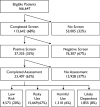A team approach to systematic behavioral screening and intervention
- PMID: 24884956
- PMCID: PMC4306562
A team approach to systematic behavioral screening and intervention
Abstract
Objectives: Unhealthy behaviors are responsible for most chronic disease, ample healthcare costs, and around 40% of deaths. This study assessed patient satisfaction and behavioral outcomes for a program that enables healthcare settings to deliver evidence-based, cost-saving behavioral screening and intervention (BSI) services, as recommended by the US Preventive Services Task Force and others.
Study design: Pre-post program evaluation.
Methods: Thirty-one diverse primary care clinics and 2 other sites participated. Over 110,000 patients completed multibehavioral screening questionnaires. Those with positive alcohol or drug screens met with dedicated, on-site health educators for further assessment, and then received either reinforcement, brief intervention, or referral. Over 300 patients completed satisfaction questionnaires during year 3 of the program. A pseudo-randomly selected group of 675 patients participated in a 6-month follow-up telephone interview. In addition, for a short time in a pilot project at 3 clinics, 29 patients received depression screening, collaborative care, and behavioral activation, and 22 completed a 3-month follow-up telephone interview.
Results: Mean patient satisfaction scores for all services exceeded 4.2 on a 5-point scale. Over 6 months, binge drinking episodes declined by over 20% for most subgroups. Recent marijuana use decreased by 15%. Depression symptom scores decreased by 55%.
Conclusions: With intensive training and ongoing support, cost-efficient paraprofessionals can deliver effective alcohol, drug, and depression screening and intervention services in busy healthcare settings. The approach holds promise for systematically addressing on a population-wide basis a variety of important behavioral health determinants and reducing related healthcare costs.
Conflict of interest statement
Figures


Similar articles
-
Screening and brief intervention for alcohol and other abuse.Adolesc Med State Art Rev. 2014 Apr;25(1):126-56. Adolesc Med State Art Rev. 2014. PMID: 25022191 Review.
-
Alcohol abuse and illegal drug use among Los Angeles County trauma patients: prevalence and evaluation of single item screener.J Trauma. 2009 May;66(5):1461-7. doi: 10.1097/TA.0b013e318184821d. J Trauma. 2009. PMID: 19430255 Free PMC article.
-
A Brief Patient Self-administered Substance Use Screening Tool for Primary Care: Two-site Validation Study of the Substance Use Brief Screen (SUBS).Am J Med. 2015 Jul;128(7):784.e9-19. doi: 10.1016/j.amjmed.2015.02.007. Epub 2015 Mar 10. Am J Med. 2015. PMID: 25770031 Free PMC article.
-
Healthcare utilization and symptom variation among veterans using Behavioral Telehealth Center services.J Behav Health Serv Res. 2013 Oct;40(4):416-26. doi: 10.1007/s11414-013-9338-y. J Behav Health Serv Res. 2013. PMID: 23616251
-
[Addictive behaviors in the aged].Geriatr Psychol Neuropsychiatr Vieil. 2012 Sep;10(3):315-24. doi: 10.1684/pnv.2012.0355. Geriatr Psychol Neuropsychiatr Vieil. 2012. PMID: 23015240 Review. French.
Cited by
-
Provider-Level Variation in Smoking Cessation Assistance Provided in the Cardiology Clinics: Insights From the NCDR PINNACLE Registry.J Am Heart Assoc. 2019 Jul 2;8(13):e011412. doi: 10.1161/JAHA.118.011307. Epub 2019 Jun 28. J Am Heart Assoc. 2019. PMID: 31248329 Free PMC article.
-
Health Care Utilization After Paraprofessional-administered Substance Use Screening, Brief Intervention, and Referral to Treatment: A Multi-level Cost-offset Analysis.Med Care. 2019 Sep;57(9):673-679. doi: 10.1097/MLR.0000000000001162. Med Care. 2019. PMID: 31295165 Free PMC article.
-
Alcohol Screening and Intervention Among United States Adults who Attend Ambulatory Healthcare.J Gen Intern Med. 2016 Jul;31(7):739-45. doi: 10.1007/s11606-016-3614-5. Epub 2016 Feb 9. J Gen Intern Med. 2016. PMID: 26862079 Free PMC article. Clinical Trial.
-
Substance Use Screening, Brief Intervention, and Referral to Treatment Among Medicaid Patients in Wisconsin: Impacts on Healthcare Utilization and Costs.J Behav Health Serv Res. 2017 Jan;44(1):102-112. doi: 10.1007/s11414-016-9510-2. J Behav Health Serv Res. 2017. PMID: 27221694 Free PMC article.
-
Workforce and systems change to treat adolescent substance use disorder within integrated pediatric primary care: A cluster-randomized stepped-wedge trial.Contemp Clin Trials. 2025 Jul;154:107928. doi: 10.1016/j.cct.2025.107928. Epub 2025 Apr 27. Contemp Clin Trials. 2025. PMID: 40300712 Free PMC article.
References
-
- U.S. Preventive Services Task Force. Recommendations. http://www.uspreventiveservicestaskforce.org/recommendations.htm.
-
- Fiore M, et al. Treating tobacco use and dependence: 2008 update. Bethesda, MD: Public Health Service; 2008.
-
- Sebelius K. US Department of Health and Human Services Strategic Plan; Fiscal Years 2010 – 2015. Washington, DC: Department of Health and Human Services; 2010. Accessed at http://www.hhs.gov/secretary/about/priorities/strategicplan2010–2015.pdf on February 16, 2012.
-
- Benjamin R. The national prevention and health promotion strategy, draft framework. Washington, DC: Office of the Surgeon General; 2010. Accessed at http://www.healthcare.gov/prevention/nphpphc/strategy/report.pdf on February 16, 2012.
-
- Helping Patients Who Drink Too Much; A Clinician’s Guide, updated 2005 edition. National Institute on Alcohol Abuse and Alcoholism; Rockville, MD: National Institute on Alcohol Abuse and Alcoholism; 2007. (NIH Publication No. 07-3769). Accessed at http://pubs.niaaa.nih.gov/publications/Practitioner/CliniciansGuide2005/... on February 16, 2012.
Publication types
MeSH terms
Grants and funding
LinkOut - more resources
Full Text Sources
Medical
Miscellaneous
